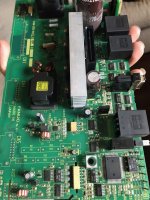BT Fabrication
Titanium
- Joined
- Nov 3, 2019
- Location
- Ontario Canada
Planning on doing that to take it out and test it.If you have found a culprit, always desolder and test out of circuit, then usually replace any that are in parallel as they could have been stressed from that failure. I have had it happen to me to replace one just to see another one fail in 10min. You may also be able to spot some upgrade components of higher voltage rating which can help protect the system. High voltage transients can take out diodes.
I don’t see anything else for other diodes in the same circuit.
Looks like the previous work done might have been all the small capacitors being replaced as the larger older lxg caps are all brown wrap and newer ones are all blue along with a small transistor that looks to be replaced cleanly.
This diode looks like both diodes in it work both in reverse and have no resistance either direction
As for upgrade components, as in? I’m not super up to date with electronic repairs.
as for tracing the multi layer pcb board, quite challenging here



